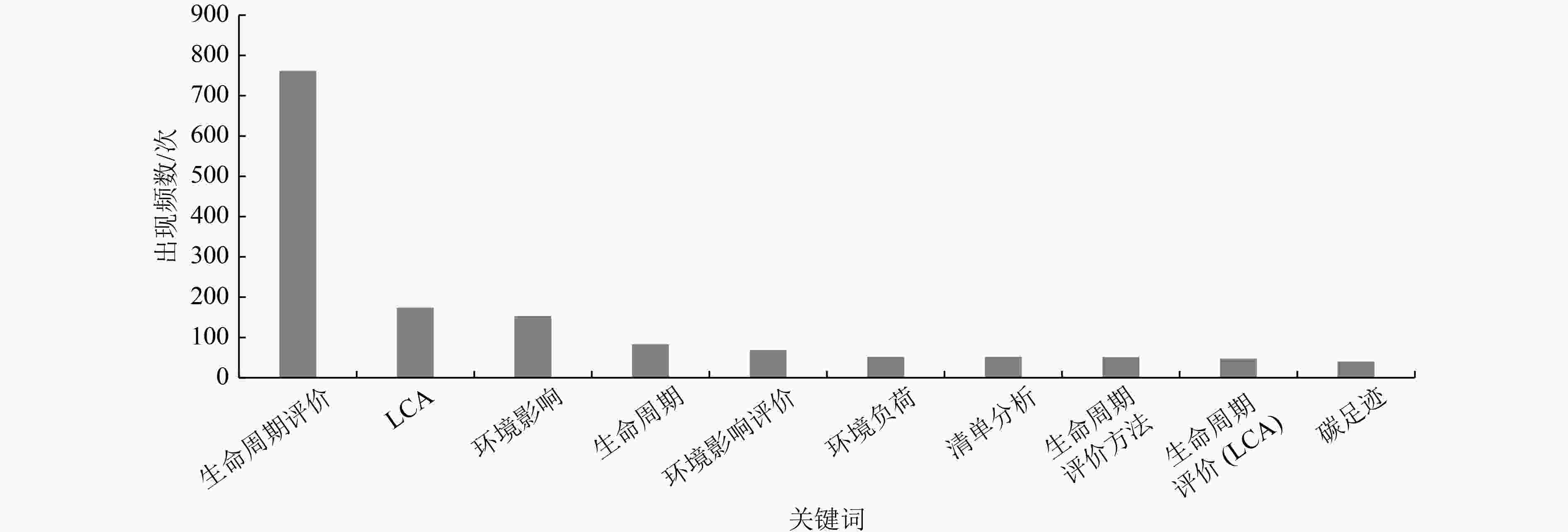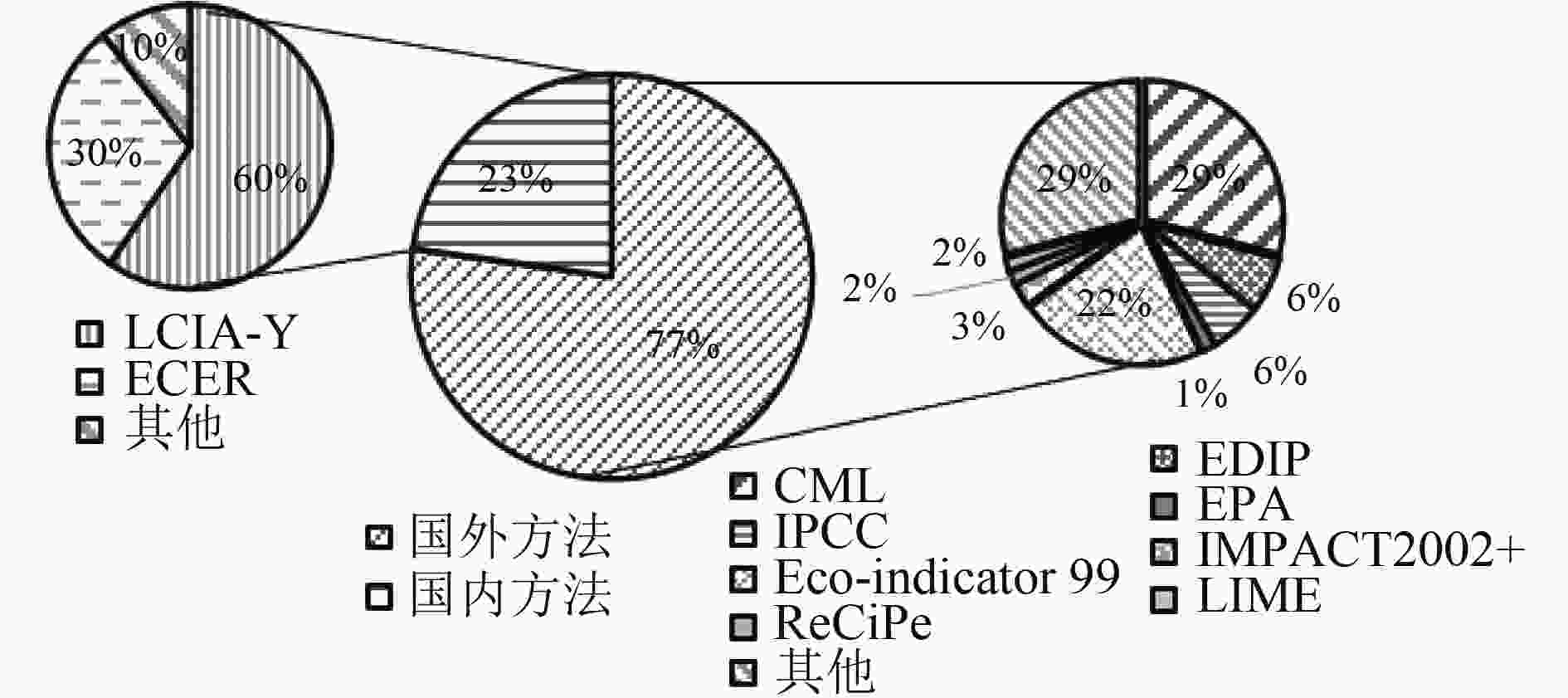Research progress on the life cycle impact assessment methods and their localization in China
-
摘要:
为推动我国生命周期影响评价方法的构建,采用文献梳理法对生命周期影响评价方法及本地化研究的现状与未来发展方向进行分析。首先回顾了生命周期评价的起源与发展,探讨了生命周期评价在我国取得的进展与存在的不足;其次对生命周期影响评价理论与方法进行了介绍,并利用文献计量学方法分析了我国学者在生命周期评价时所使用的方法,结果显示77%的研究均采用国外的影响评价方法;最后梳理了我国生命周期影响评价方法的本地化研究进展,分析了现阶段生命周期影响评价方法的3点不足,包括所选取的指标及基准值亟须更新,模型系统性和完整性需要加强,模型深入研究有待展开,并提出要探索构建适合我国国情的完整全面的生命周期影响评价方法以及相应的参数基准值,从而提高我国生命周期评价结果的真实性、准确性,为环境政策制定以及相关产业发展提供决策支持。
Abstract:In order to promote the construction of life cycle impact assessment (LCIA) methods in China, the current situation and future development direction of LCIA methods and their localization research were analyzed by the literature review. Firstly, the origin and development of life cycle assessment (LCA) were reviewed, and the progress and shortcomings of LCA in China were discussed. Secondly, the theories and methods of LCIA were introduced, and the impact assessment methods used by Chinese scholars in LCA were analyzed using the bibliometric method. The results showed that 77% of the studies adopted foreign impact assessment methods. Finally, the localization research progress of LCIA methods in China were combed, and three deficiencies of LCIA methods at this stage were found, namely, the need to update the selected indicators and benchmark values, the need to strengthen the systematicness and integrity of the model, and the need to carry out the in-depth research of the model. It was proposed that complete and comprehensive LCIA methods and corresponding parameter benchmark values suitable for China's national conditions should be explored and built, so as to improve the authenticity and accuracy of China's LCA results and provide decision support for China's environmental policy-making and related industrial development.
-
表 1 生命周期影响评价指标介绍
Table 1. Introduction of life cycle impact assessment indicators
影响类别 影响路径 评价模型 气候变化 CO2等温室气体排放会增加大气对辐射的吸收,引起气温升高并带来短期和长期气候变化问题 短期:全球变暖潜值GWP100。
长期:全球温度变化潜力GTP100[17]细颗粒物 PM2.5排放到空气中会被人体吸入,时间越久其在体内积聚越多,从而造成人体健康风险 USEtox模型[18] 水短缺 家庭用水短缺会使人们摄入低质量不卫生的水,导致腹泻等传染病,影响人体健康;农业用水短缺会使农业与渔业产量减少,造成因粮食供应不足,进而导致人体营养不良 因果链模型[19-22] 土地利用 土地利用变化通过改变土壤性质和植被覆盖率对物种与生态系统造成影响,进而影响生物多样性 潜在物种损失模型[23-24] 人类毒性 产品的化学物质排放到环境中,通过空气、食物等途径对人类健康(癌症和非癌症)造成影响 USEtox模型[25-27] 生态毒性 产品的化学物质排放到环境中,通过物种摄入及与其他物种相互作用,对生态系统造成损害 USEtox模型[28-29] 陆地酸化 硫氧化物、氮氧化物等物质排放到空气中并反应生成酸化或氧化还原物质,沉积到陆地或植被表面,最终进入土壤,造成陆地系统的酸化 中点法:陆地酸化潜力模型[30]。
终点法:陆地生态系统损害模型[31]富营养化
(淡水)限制性营养物(如无机磷和氮化合物等)过量排放到水体中,导致浮游植物生长,溶解氧浓度降低,进而造成淡水的富营养化 中点法:淡水富营养化潜力[32](以磷当量计算)。
终点法:磷对淡水生态系统的损害[32]富营养化
(海水)限制性营养物(如无机磷和氮化合物等)过量排放到水体中,导致浮游植物生长,溶解氧浓度降低,进而造成海水的富营养化 中点法:海水富营养化潜力[33](以氮当量计算)。
终点法:氮对海水生态系统的损害[34]矿产资源 由于人类活动造成在技术领域利用矿产资源(铜、石膏、沙等)为人类提供价值的潜力损失 损耗法[35-36]、未来努力法[37-40]、热力学核算法[41-43]、供应风险法[44-46] 土壤质量 由于人类活动造成土地利用变化,使得土壤物理、化学、生物性质发生改变 土壤有机碳模型[47]、土壤侵蚀模型[48]、生物生产力模型[49] -
[1] 白璐, 孙启宏, 乔琦.生命周期评价在国内的研究进展评述[J]. 安徽农业科学,2010,38(5):2553-2555. doi: 10.3969/j.issn.0517-6611.2010.05.128BAI L, SUN Q H, QIAO Q. Review of research progresses of life cycle assessment in China[J]. Journal of Anhui Agricultural Sciences,2010,38(5):2553-2555. doi: 10.3969/j.issn.0517-6611.2010.05.128 [2] 马雪, 王洪涛.生命周期评价在国内的研究与应用进展分析[J]. 化学工程与装备,2015(2):164-166. [3] 国家质量监督检验检疫总局, 中国国家标准化管理委员会. 环境管理 生命周期评价 原则与框架: GB/T 24040—2008[S]. 北京: 中国标准出版社, 2008. [4] 杨建新, 刘炳江.中国钢材生命周期清单分析[J]. 环境科学学报,2002,22(4):519-522. doi: 10.3321/j.issn:0253-2468.2002.04.021YANG J X, LIU B J. Life cycle inventory of steel products in China[J]. Acta Scientiae Circumstantiae,2002,22(4):519-522. doi: 10.3321/j.issn:0253-2468.2002.04.021 [5] 刘夏璐, 王洪涛, 陈建, 等.中国生命周期参考数据库的建立方法与基础模型[J]. 环境科学学报,2010,30(10):2136-2144. doi: 10.13671/j.hjkxxb.2010.10.028LIU X L, WANG H T, CHEN J, et al. Method and basic model for development of Chinese reference life cycle database[J]. Acta Scientiae Circumstantiae,2010,30(10):2136-2144. doi: 10.13671/j.hjkxxb.2010.10.028 [6] 李小青, 龚先政, 聂祚仁, 等.中国材料生命周期评价数据模型及数据库开发[J]. 中国材料进展,2016,35(3):171-178. doi: 10.7502/j.issn.1674-3962.2016.03.02LI X Q, GONG X Z, NIE Z R, et al. Data model and database development for materials life cycle assessment in China[J]. Materials China,2016,35(3):171-178. doi: 10.7502/j.issn.1674-3962.2016.03.02 [7] 王玉涛, 王丰川, 洪静兰, 等.中国生命周期评价理论与实践研究进展及对策分析[J]. 生态学报,2016,36(22):7179-7184.WANG Y T, WANG F C, HONG J L, et al. The development of life cycle assessment theory research in China and analysis of countermeasures[J]. Acta Ecologica Sinica,2016,36(22):7179-7184. [8] DREYER L C, NIEMANN A L, HAUSCHILD M Z. Comparison of three different LCIA methods: EDIP97, CML2001 and Eco-indicator 99[J]. The International Journal of Life Cycle Assessment,2003,8(4):191-200. doi: 10.1007/BF02978471 [9] STEM B. A systematic approach to environmental strategies in product development (EPS), Version 2000:general system characteristics, models and data of the default methods[R]. Chalmers University of Technology, Centre for Environmental Assessment of Products and Material Systems, 1999. [10] TOFFOLETTO L, BULLE C, GODIN J, et al. LUCAS: a new LCIA method used for a Canadian-specific context[J]. The International Journal of Life Cycle Assessment,2007,12(2):93-102. doi: 10.1065/lca2005.12.242 [11] BARE J. TRACI 2.0: the tool for the reduction and assessment of chemical and other environmental impacts 2.0[J]. Clean Technologies and Environmental Policy,2011,13(5):687-696. doi: 10.1007/s10098-010-0338-9 [12] GOEDKOOP M, SPRIENSMA R. The Eco-Indicator 99: a damage oriented method for life cycle impact assessment[J]. Methodology Report,1999,11(1):95. [13] JOLLIET O, MARGNI M, CHARLES R, et al. IMPACT 2002+: a new life cycle impact assessment methodology[J]. The International Journal of Life Cycle Assessment,2003,8(6):324-330. doi: 10.1007/BF02978505 [14] OWSIANIAK M, LAURENT A, BJØRN A, et al. IMPACT 2002+, ReCiPe 2008 and ILCD's recommended practice for characterization modelling in life cycle impact assessment: a case study-based comparison[J]. The International Journal of Life Cycle Assessment,2014,19(5):1007-1021. doi: 10.1007/s11367-014-0708-3 [15] VERONES F, HENDERSON A D, LAURENT A, et al. Global guidance for life cycle impact assessment indicators (volume 1)[M]. Nairobi: United Nations Environment Programme, 2016. [16] FRISCHKNECHT R, JOLLIET O. Global guidance for life cycle impact assessment indicators (volume 2)[M]. Nairobi: United Nations Environment Programme, 2019. [17] SHINE K P, FUGLESTVEDT J S, HAILEMARIAM K, et al. Alternatives to the global warming potential for comparing climate impacts of emissions of greenhouse gases[J]. Climatic Change,2005,68(3):281-302. doi: 10.1007/s10584-005-1146-9 [18] BENNETT D H, MCKONE T E, EVANS J S, et al. Defining intake fraction[J]. Environmental Science & Technology,2002,36(9):207A-211A. [19] FANTKE P, JOLLIET O, EVANS J S, et al. Health effects of fine particulate matter in life cycle impact assessment: findings from the Basel Guidance Workshop[J]. The International Journal of Life Cycle Assessment,2015,20(2):276-288. doi: 10.1007/s11367-014-0822-2 [20] MOTOSHITA M, ITSUBO N, INABA A. Development of impact factors on damage to health by infectious diseases caused by domestic water scarcity[J]. The International Journal of Life Cycle Assessment,2011,16(1):65-73. doi: 10.1007/s11367-010-0236-8 [21] PFISTER S, KOEHLER A, HELLWEG S. Assessing the environmental impacts of freshwater consumption in LCA[J]. Environmental Science & Technology,2009,43(11):4098-4104. [22] MOTOSHITA M, ONO Y, PFISTER S, et al. Consistent characterisation factors at midpoint and endpoint relevant to agricultural water scarcity arising from freshwater consumption[J]. The International Journal of Life Cycle Assessment,2018,23(12):2276-2287. doi: 10.1007/s11367-014-0811-5 [23] CURRAN M, MAIA de SOUZA D, ANTÓN A, et al. How well does LCA model land use impacts on biodiversity: a comparison with approaches from ecology and conservation[J]. Environmental Science & Technology,2016,50(6):2782-2795. [24] CHAUDHARY A, VERONES F, de BAAN L, et al. Quantifying land use impacts on biodiversity: combining species-area models and vulnerability indicators[J]. Environmental Science & Technology,2015,49(16):9987-9995. [25] ROSENBAUM R K, BACHMANN T M, GOLD L S, et al. USEtox: the UNEP-SETAC toxicity model: recommended characterisation factors for human toxicity and freshwater ecotoxicity in life cycle impact assessment[J]. The International Journal of Life Cycle Assessment,2008,13(7):532-546. doi: 10.1007/s11367-008-0038-4 [26] FANTKE P, ERNSTOFF A S, HUANG L, et al. Coupled near-field and far-field exposure assessment framework for chemicals in consumer products[J]. Environment International,2016,94:508-518. doi: 10.1016/j.envint.2016.06.010 [27] JOLLIET O, ERNSTOFF A S, CSISZAR S A, et al. Defining product intake fraction to quantify and compare exposure to consumer products[J]. Environmental Science & Technology,2015,49(15):8924-8931. [28] JOLLIET O, ROSENBAUM R, MCKONE T E, et al. Establishing a framework for life cycle toxicity assessment. findings of the Lausanne review workshop[J]. The International Journal of Life Cycle Assessment,2006,11(3):209-212. doi: 10.1065/lca2006.03.002 [29] ROSENBAUM R K, MARGNI M, JOLLIET O. A flexible matrix algebra framework for the multimedia multipathway modeling of emission to impacts[J]. Environment International,2007,33(5):624-634. doi: 10.1016/j.envint.2007.01.004 [30] ROY P O, HUIJBREGTS M, DESCHÊNES L, et al. Spatially-differentiated atmospheric source-receptor relationships for nitrogen oxides, sulfur oxides and ammonia emissions at the global scale for life cycle impact assessment[J]. Atmospheric Environment,2012,62:74-81. doi: 10.1016/j.atmosenv.2012.07.069 [31] AZEVEDO L B, van ZELM R, ELSHOUT P M F, et al. Species richness-phosphorus relationships for lakes and streams worldwide[J]. Global Ecology and Biogeography,2013,22(12):1304-1314. doi: 10.1111/geb.12080 [32] HELMES R J K, HUIJBREGTS M A J, HENDERSON A D, et al. Spatially explicit fate factors of phosphorous emissions to freshwater at the global scale[J]. The International Journal of Life Cycle Assessment,2012,17(5):646-654. doi: 10.1007/s11367-012-0382-2 [33] MAYORGA E, SEITZINGER S P, HARRISON J A, et al. Global nutrient export from WaterSheds 2 (NEWS 2): model development and implementation[J]. Environmental Modelling & Software,2010,25(7):837-853. [34] COSME N, MAYORGA E, HAUSCHILD M Z. Spatially explicit fate factors of waterborne nitrogen emissions at the global scale[J]. The International Journal of Life Cycle Assessment,2018,23(6):1286-1296. doi: 10.1007/s11367-017-1349-0 [35] GUINÉE J B, HEIJUNGS R. A proposal for the definition of resource equivalency factors for use in product life-cycle assessment[J]. Environmental Toxicology and Chemistry,1995,14(5):917-925. doi: 10.1002/etc.5620140525 [36] SCHNEIDER L, BERGER M, FINKBEINER M. The anthropogenic stock extended abiotic depletion potential (AADP) as a new parameterisation to model the depletion of abiotic resources[J]. The International Journal of Life Cycle Assessment,2011,16(9):929-936. doi: 10.1007/s11367-011-0313-7 [37] VIEIRA M D M, GOEDKOOP M J, STORM P, et al. Ore grade decrease as life cycle impact indicator for metal scarcity: the case of copper[J]. Environmental Science & Technology,2012,46(23):12772-12778. [38] SWART P, DEWULF J. Quantifying the impacts of primary metal resource use in life cycle assessment based on recent mining data[J]. Resources, Conservation and Recycling,2013,73:180-187. doi: 10.1016/j.resconrec.2013.02.007 [39] WEIDEMA B P. Using the budget constraint to monetarise impact assessment results[J]. Ecological Economics,2009,68(6):1591-1598. doi: 10.1016/j.ecolecon.2008.01.019 [40] VIEIRA M, PONSIOEN T, GOEDKOOP M, et al. Surplus cost potential as a life cycle impact indicator for metal extraction[J]. Resources,2016,5(1):2. doi: 10.3390/resources5010002 [41] DEWULF J, BÖSCH M E, de MEESTER B, et al. Cumulative exergy extraction from the natural environment (CEENE): a comprehensive life cycle impact assessment method for resource accounting[J]. Environmental Science & Technology,2007,41(24):8477-8483. [42] BÖSCH M E, HELLWEG S, HUIJBREGTS M A J, et al. Applying cumulative exergy demand (CExD) indicators to the ecoinvent database[J]. The International Journal of Life Cycle Assessment,2007,12(3):181-190. doi: 10.1065/lca2006.11.282 [43] RUGANI B, HUIJBREGTS M A J, MUTEL C, et al. Solar energy demand (SED) of commodity life cycles[J]. Environmental Science & Technology,2011,45(12):5426-5433. [44] GEMECHU E D, HELBIG C, SONNEMANN G, et al. Import-based indicator for the geopolitical supply risk of raw materials in life cycle sustainability assessments[J]. Journal of Industrial Ecology,2016,20(1):154-165. doi: 10.1111/jiec.12279 [45] SCHNEIDER L, BERGER M, SCHÜLER-HAINSCH E, et al. The economic resource scarcity potential (ESP) for evaluating resource use based on life cycle assessment[J]. The International Journal of Life Cycle Assessment,2014,19(3):601-610. doi: 10.1007/s11367-013-0666-1 [46] BACH V, BERGER M, HENßLER M, et al. Integrated method to assess resource efficiency: ESSENZ[J]. Journal of Cleaner Production,2016,137:118-130. doi: 10.1016/j.jclepro.2016.07.077 [47] BRANDÃO M, CANALS L M. Global characterisation factors to assess land use impacts on biotic production[J]. The International Journal of Life Cycle Assessment,2013,18(6):1243-1252. doi: 10.1007/s11367-012-0381-3 [48] RENARD K G, FOSTER G R, WEESIES G A, et al. RUSLE: revised universal soil loss equation[J]. Journal of Soil and Water Conservation,1991,46(1):30-33. [49] NÚÑEZ M, ANTÓN A, MUÑOZ P, et al. Inclusion of soil erosion impacts in life cycle assessment on a global scale: application to energy crops in Spain[J]. The International Journal of Life Cycle Assessment,2013,18(4):755-767. doi: 10.1007/s11367-012-0525-5 [50] 杨建新, 王如松, 刘晶茹.中国产品生命周期影响评价方法研究[J]. 环境科学学报,2001,21(2):234-237. doi: 10.3321/j.issn:0253-2468.2001.02.022YANG J X, WANG R S, LIU J R. Methodology of life cycle impact assessment for Chinese products[J]. Acta Scientiae Circumstantiae,2001,21(2):234-237. doi: 10.3321/j.issn:0253-2468.2001.02.022 [51] 王洪涛.通往节能减排目标的新途径:生命周期节能减排评价方法[J]. 高科技与产业化,2011(08):49-53. [52] 谢明辉, 阮久莉, 白璐, 等.太阳能级多晶硅生命周期环境影响评价[J]. 环境科学研究,2015,28(2):291-296. doi: 10.13198/j.issn.1001-6929.2015.02.17XIE M H, RUAN J L, BAI L, et al. Environmental impacts of solar grade polysilicon based on Life Cycle Assessment[J]. Research of Environmental Sciences,2015,28(2):291-296. doi: 10.13198/j.issn.1001-6929.2015.02.17 [53] 谢明辉, 阮久莉, 乔琦, 等.基于生命周期评价的多晶硅片环境影响研究[J]. 环境工程技术学报,2016,6(1):72-77. doi: 10.3969/j.issn.1674-991X.2016.01.011XIE M H, RUAN J L, QIAO Q, et al. Research on environmental impacts of multi-silicon wafer based on Life Cycle Assessment[J]. Journal of Environmental Engineering Technology,2016,6(1):72-77. doi: 10.3969/j.issn.1674-991X.2016.01.011 [54] 杨冬璐, 马逍天, 洪静兰.基于生命周期评价的造纸废水的水足迹[J]. 山东大学学报(工学版),2019,49(3):114-119.YANG D L, MA X T, HONG J L. Life cycle assessment-based water footprint analysis of paper making wastewater[J]. Journal of Shandong University (Engineering Science),2019,49(3):114-119. [55] 侯萍, 王洪涛, 朱永光, 等.中国资源能源稀缺度因子及其在生命周期评价中的应用[J]. 自然资源学报,2012,27(9):1572-1579. doi: 10.11849/zrzyxb.2012.09.014HOU P, WANG H T, ZHU Y G, et al. Chinese scarcity factors of resources/energy and their application in life cycle assessment[J]. Journal of Natural Resources,2012,27(9):1572-1579. doi: 10.11849/zrzyxb.2012.09.014 [56] 张培, 田长生, 黄志甲.钢铁产品生命周期影响评价方法[J]. 安徽工业大学学报(自然科学版),2007,24(1):84-88.ZHANG P, TIAN C S, HUANG Z J. Life cycle impact assessment method for iron and steel products[J]. Journal of Anhui University of Technology (Natural Science),2007,24(1):84-88. [57] 苏向东, 王天民, 何力, 等.有色金属材料的环境负荷定量评价模型[J]. 环境科学学报,2002,22(1):98-102. doi: 10.3321/j.issn:0253-2468.2002.01.020SU X D, WANG T M, HE L, et al. Quantitative LCA study on non-ferrous metallic materials[J]. Acta Scientiae Circumstantiae,2002,22(1):98-102. doi: 10.3321/j.issn:0253-2468.2002.01.020 [58] CHEN W, ZHANG F F, HONG J L, et al. Life cycle toxicity assessment on deep-brine well drilling[J]. Journal of Cleaner Production,2016,112:326-332. doi: 10.1016/j.jclepro.2015.07.062 [59] LI X Z, YANG Y, XU X, et al. Air pollution from polycyclic aromatic hydrocarbons generated by human activities and their health effects in China[J]. Journal of Cleaner Production,2016,112:1360-1367. doi: 10.1016/j.jclepro.2015.05.077 [60] 李雪迎, 白璐, 杨庆榜, 等.我国终点型生命周期影响评价模型及基准值初步研究[J]. 环境科学研究,2021,34(11):2778-2786. doi: 10.13198/j.issn.1001-6929.2021.08.05LI X Y, BAI L, YANG Q B, et al. Preliminary study on endpoint life cycle impact assessment model and normalisation value in China[J]. Research of Environmental Sciences,2021,34(11):2778-2786. doi: 10.13198/j.issn.1001-6929.2021.08.05 [61] PIZZOL M, WEIDEMA B, BRANDÃO M, et al. Monetary valuation in life cycle assessment: a review[J]. Journal of Cleaner Production,2015,86:170-179. doi: 10.1016/j.jclepro.2014.08.007 [62] DONG Y, HAUSCHILD M, SØRUP H, et al. Evaluating the monetary values of greenhouse gases emissions in life cycle impact assessment[J]. Journal of Cleaner Production,2019,209:538-549. doi: 10.1016/j.jclepro.2018.10.205 [63] HUYSEGOMS L, ROUSSEAU S, CAPPUYNS V. Friends or foes: monetized life cycle assessment and cost-benefit analysis of the site remediation of a former gas plant[J]. Science of the Total Environment,2018,619/620:258-271. doi: 10.1016/j.scitotenv.2017.10.330 [64] 陈娴, 黄蓓佳, 王翔宇, 等.太阳能光伏组件环境成本的货币化核算研究[J]. 复旦学报(自然科学版),2019,58(1):120-126. doi: 10.15943/j.cnki.fdxb-jns.2019.01.015CHEN X, HUANG B J, WANG X Y, et al. Research on monetary accounting of environmental cost of solar PV[J]. Journal of Fudan University (Natural Science),2019,58(1):120-126. □ doi: 10.15943/j.cnki.fdxb-jns.2019.01.015 -





 下载:
下载:




